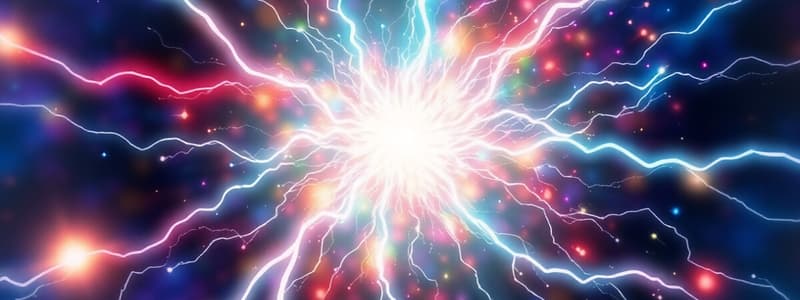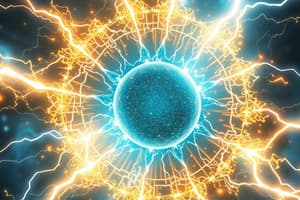Podcast
Questions and Answers
Why do objects become charged in static electricity demonstrations?
Why do objects become charged in static electricity demonstrations?
- Due to the creation of new protons on the object's surface.
- Due to the transfer of electrons between objects. (correct)
- Due to the physical removal of neutrons from one object to another.
- Due to the conversion of matter into energy upon rubbing.
What fundamental property did William Gilbert discover regarding static electricity?
What fundamental property did William Gilbert discover regarding static electricity?
- All materials are electrically neutral and cannot be charged.
- Only amber can exhibit attractive properties when rubbed.
- Many materials, not just amber, exhibit attractive properties when rubbed. (correct)
- Static electricity only occurs in the presence of a magnetic field.
Why does rubbing a balloon with wool cause it to attract small pieces of paper?
Why does rubbing a balloon with wool cause it to attract small pieces of paper?
- The wool transfers protons to the balloon.
- The wool transfers electrons to the balloon. (correct)
- Rubbing the balloon creates a magnetic field.
- The balloon loses neutrons to the wool, creating a charge imbalance.
What causes the mild electric shock experienced when touching a metal doorknob after walking on carpet?
What causes the mild electric shock experienced when touching a metal doorknob after walking on carpet?
In an electrically neutral atom, which statement accurately describes the relationship between electrons and protons?
In an electrically neutral atom, which statement accurately describes the relationship between electrons and protons?
What is the charge of a neutron?
What is the charge of a neutron?
When an atom loses electrons, what type of ion does it form?
When an atom loses electrons, what type of ion does it form?
What type of charge is observed on a rubber rod after it has been rubbed with fur?
What type of charge is observed on a rubber rod after it has been rubbed with fur?
If a neutral atom gains electrons, what is the resulting charge of the atom?
If a neutral atom gains electrons, what is the resulting charge of the atom?
Why is static electricity not easily observed in most materials under normal conditions?
Why is static electricity not easily observed in most materials under normal conditions?
What is the magnitude of an electron charge?
What is the magnitude of an electron charge?
What constitutes one coulomb of charge?
What constitutes one coulomb of charge?
Why do electrons closer to the nucleus experience a stronger force compared to those farther away?
Why do electrons closer to the nucleus experience a stronger force compared to those farther away?
Which of the following is the smallest unit for measuring charge?
Which of the following is the smallest unit for measuring charge?
What is the primary constituent of an atom's nucleus?
What is the primary constituent of an atom's nucleus?
What consequence results from rubbing a glass rod with silk?
What consequence results from rubbing a glass rod with silk?
A child gets an electric shock after sliding down a plastic slide and then touching a metal pole. What is the primary reason for this shock?
A child gets an electric shock after sliding down a plastic slide and then touching a metal pole. What is the primary reason for this shock?
How do the numbers of protons and electrons compare in a positively charged ion?
How do the numbers of protons and electrons compare in a positively charged ion?
Which statement accurately describes the electrical properties of protons and electrons?
Which statement accurately describes the electrical properties of protons and electrons?
Around what year did William Gilbert discover that many materials exhibit attractive properties when rubbed?
Around what year did William Gilbert discover that many materials exhibit attractive properties when rubbed?
Flashcards
What is static electricity?
What is static electricity?
Generating electrical charges on an object by transferring electrons.
Gilbert's Discovery (1600 AD)
Gilbert's Discovery (1600 AD)
Many materials attract light objects when rubbed.
Static Electricity (Definition)
Static Electricity (Definition)
The generation of electric charges on an object due to the transfer of electrons.
Why does attraction happen?
Why does attraction happen?
Signup and view all the flashcards
Cause of Electric Shock
Cause of Electric Shock
Signup and view all the flashcards
What are neutrons?
What are neutrons?
Signup and view all the flashcards
Electrical Neutrality
Electrical Neutrality
Signup and view all the flashcards
Positive Charge
Positive Charge
Signup and view all the flashcards
Negative Charge
Negative Charge
Signup and view all the flashcards
Positive Ion Formation
Positive Ion Formation
Signup and view all the flashcards
Negative Ion Formation
Negative Ion Formation
Signup and view all the flashcards
What do electrons do?
What do electrons do?
Signup and view all the flashcards
Electron or Proton
Electron or Proton
Signup and view all the flashcards
Study Notes
Introduction to Static Electricity
- Static electricity involves generating electrical charges on an object through the transfer of electrons to or from it.
- The ancient Greeks, around 600 BC, discovered that rubbing amber with wool made it attract light objects like paper.
- In 1600 AD, William Gilbert found that many materials, not just amber, exhibit this attractive property when rubbed.
- All materials contain electric charges, but they are static and not easily observed, requiring specific methods to reveal them.
Demonstrations of Static Electricity
- Rubbing a ruler with wool causes it to attract materials, showcasing the acquisition of electric charges.
- A balloon rubbed with wool becomes charged and attracts objects, illustrating static electricity.
- Balloons that are not rubbed do not attract materials.
Definition of Static Electricity
- Static electricity refers to the generation of electric charges on an objectdue to the transfer of electrons.
Examples of Static Electricity
- Small paper pieces get attracted to a plastic comb after rubbing it through hair, as the comb becomes charged.
- Paper pieces stick to a balloon after the balloon is rubbed with wool; the balloon becomes charged.
- Hair is attracted to a balloon rubbed with wool because the balloon becomes charged.
- Explanation: Attraction happens because static electric charges cause objects to become charged.
Experiencing Electric Shock
- A mild electric shock may occur when wearing wool clothes and touching a metal doorknob due to charge transfer.
- Cause: The friction between the wool clothing and the body generates electric charges, which discharge upon touching a metal object.
- Children may get electric shocks after sliding on plastic slides and touching a metal pole, again due to accumulated charges.
- Reason: Shocks occur because of the electric discharge of accumulated charges from friction.
Atomic Structure and Electric Charge
- Matter consists of small particles called atoms, which contain electrons.
- Electrons are negatively charged and orbit the nucleus at high speed.
- The nucleus comprises protons and neutrons.
- Protons are positively charged, while neutrons are neutral and possess zero charge.
Electrical Neutrality
- Most material atoms are electrically neutral, with equal numbers of electrons and protons.
- The force that binds electrons to the nucleus varies depending on the distance from the nucleus, that closer electrons have a stronger force and the force decreases as electrons orbit further.
Types of Electric Charge
- Positive Charge: Exemplified by protons and the charge on a glass rod rubbed with silk.
- Negative Charge: Exemplified by electrons and the charge on a rubber rod rubbed with fur.
Ion Formation
- Positive Ion Formation: Atoms can become positive ions by the loss of electrons, leading to the atom having a net positive charge.
- Negative Ion Formation: Atoms become negative ions by gaining electrons, increasing the negative charge it holds.
Additional Information for Next Session
- Protons have a positive charge equal in magnitude to the negative charge of an electron.
- An electron and a proton are considered the smallest units for measuring charge.
- Magnitude of electron charge is 1.6 x 10^-19 coulombs.
- A single coulomb is made up of 6.25 x 10^18 electrons.
Studying That Suits You
Use AI to generate personalized quizzes and flashcards to suit your learning preferences.




